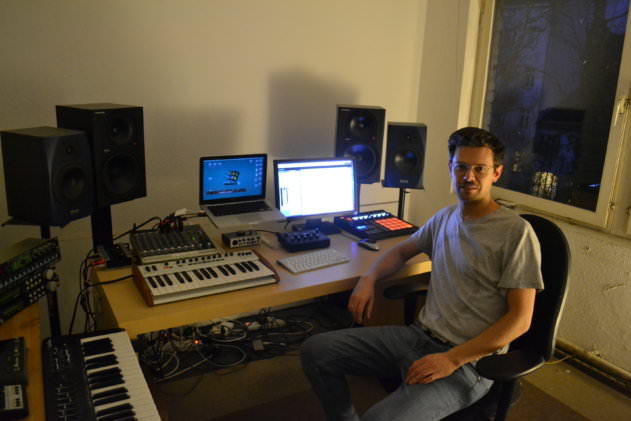The Berlin-based producer talks us through the inspirations and creative processes involved in the making of his new album, passing on a few choice production tips along the way.
It’s easy to overthink the album format. At times we’re as guilty as anyone of expecting wild concepts, narrative arcs and concessions to home listening, but every now and then it’s worth being reminded that dance music doesn’t have to play up to those rockist ideas of what an LP should be. Jay Shepheard’s newly released Seeing Sound is a great example: eight effortlessly classy house tracks, crafted solely for the dancefloor, road tested by Shepheard over the course of the last year, then compiled as a full-length release. There’s no bold concept here, but it works as an album simply because of its single-minded sense of purpose. It doesn’t try to be anything more than a collection of dancefloor tracks, and the result is an album that perfectly sums up Shepheard’s current sound.
We asked Jay to talk us through the album, explaining the genesis of each track and giving us an insight into his creative approach…
‘Spring Up’
An unusual track, this one. I had quite a debate with myself about placing it first in the running order, with its simplistic theme and brash mixdown. However, the main concept for this album was to deliver a package of pure dancefloor tackle, and in play testing, this one was consistently getting great reactions in all sizes of clubs and on all types of systems, so what better way to choose an A1 for a project like this?
I guess it’s a ‘high concept’ track: a bold central theme and minimal other ingredients. The main synth line carries the whole track, drops and breaks, alternating from straight legato to the broken chord progression. One feature I love about this sound is the fast pan in the modulation matrix, which adds a great dynamic. However, it was quite a balancing act to get right as too much of it can affect the club sound quite a bit – when stereo isn’t always perfect or if the club’s running a mono system. I played a very early version in a booth with just one monitor and it sounded terrible so it took a few tweaks to get it just right. I’m really happy with it now and have been playing it in every set for the last six months or so.
the main concept for this album was to deliver a package of pure dancefloor tackle
‘Ohm I’
Probably one of my favourite tracks from the LP and I guess one of the deeper ones. It started out with the looping pad sample which comes from an old E-mu Proteus 2000
. I love these old sample-based modules – the JV2080 is another good one too. There are some real gems of presets in these old bits – a lot of duds too, but the good ones can have great harmonics and a nice unpolished sound. They work nicely for referencing the 90s. I also used the 2000 for the main hook on my track ‘Fuzzy Border’ from a few years back.
Another element I love is the LinnDrum hi-hat. It cuts through the mix so nicely at club volume and almost takes on a kind of cowbell edge on the attack. I’m usually overcritical of my mixdowns (I do them all myself), but when the bass, pad loop and vocal drop all together at the mid point of this record it comes together pretty, pretty nicely if you ask me!
‘Mover Friendly’
This one actually started out life as a remix, but for one reason or another the release didn’t go ahead. However, I’d been testing out what I’d worked on so far and was getting a lot of people asking about it so was really keen to still get it out there somehow. I explained all this to the original artist and he was cool for me to delete the remix parts and finish off the original bits I’d written to make a new track – and ‘Mover Friendly’ was born.
Its a groover, hook-wise, and although there are only subtle variations, it seems to build all the way till the last drop. I often use this as a set opener, as the intro allows me to mix well into the groove and out of the previous track, leaving it exposed before the first kick and the sub bass drop, so it’s a nice way of transitioning sets for me. Some of my favourite plugins are the Soundtoys effects – I used them on the synth stabs for pitch delays in the breaks. I love the way those work to build unusual harmonics.
although there are only subtle variations, it seems to build all the way till the last drop
‘Beam Splitter’
This track went through a fair few versions before it ended up with the one I’ve released. The main synth theme running through the whole track was the starting point, from Arturia’s Moog Modular – still probably one of the best soft synths out there if you ask me. I love the resonance in it, with just a subtle modulation running throughout. The earlier versions had quite a few more parts, some vox samples… but one day I decided just to strip it back a bit into more of a tool. I gave that a few plays out and decided it was way better simplified – quite often the way, I find.
Although this one is pretty much all done ‘in the box’, it’s definitely one of the more raw and rough sounding tracks on the album, with the skippy shaker pattern adding a harshness to the high mids too. It’s kind of something that I wanted to experiment with a little bit across this whole release, as my last LP had quite a finished sound and was for listening at home rather than club play.


04.38 PM
Nice tracks, cool sound and you surely talk about nice synths and expanders. Your Studio seems to be right for the music you do, which i had that much place.
Keep on man.